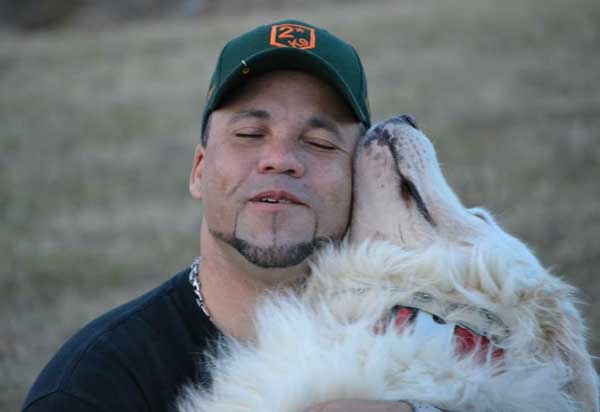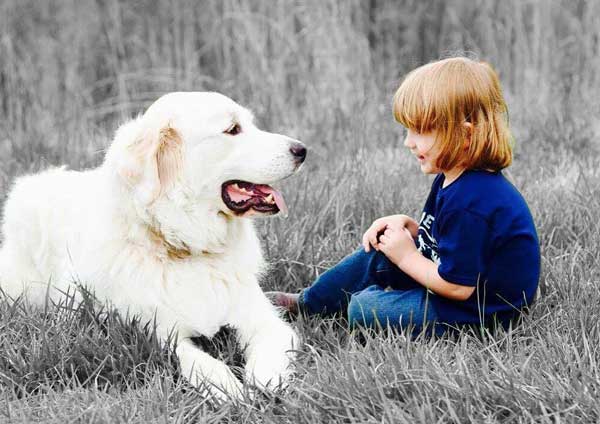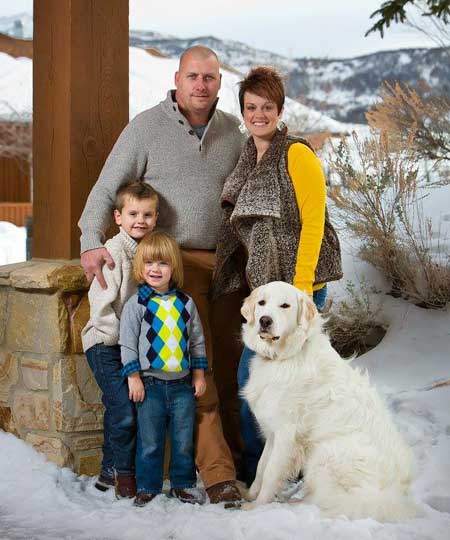
This is the fourth of a series of features on 2017’s AKC Humane Fund Awards for Canine Excellence Winners who will be honored Dec. 16-17 at the AKC National Championship presented by Royal Canin in Orlando.
“The White Fluffy Puppy That Became a Tow Truck.” Sounds like the perfect title for a children’s book, doesn’t it?
In Gunner and D. Hamilton Kinard’s case, it’s more about how a mobility-assistance and post-traumatic stress disorder (PTSD) service dog has given the Army veteran a new lease on life. But it doesn’t stop there. Gunner has been the launching pad for Britnee Kinard to found the SD Gunner Fund, a nonprofit organization providing disabled veterans and children with financial means to obtain and maintain service dogs.
And that’s why the Richmond Hill, Ga., couple and Gunner are winners of the American Kennel Club’s coveted Award for Canine Excellence (ACE) 2017 Service Dog of the year. They, along with four other ACE winners, will be honored Dec. 16-17 at the AKC National Championship presented by Royal Canin in Orlando.
The 4-year-old Gunner (Kinard chose this name because he was the gunner in the top of a Humvee) was paired with Kinard in 2013, after the veteran was classified 100 percent disabled with total body nerve damage, a traumatic brain injury, and PTSD following his service in Iraq. Altogether, Kinard was diagnosed with more than 43 injuries before being honorably discharged in 2010.

Gunner, a 4-year-old Great Pyrenees owned by Hamilton and Britnee Kinard, of Richmond Hill, Ga., and his trainer, James Quarterman get in some bonding time after a lesson. Training is split between the Kinards’ home and Quarterman’s in West Columbia, S.C.
Once the U.S. Department of Veterans Affairs (VA) approved Kinard as being eligible for a service dog, he and his wife worked with multiple agencies and narrowed the final decision down to three dogs – a , a and “a cute, white fluffy puppy.”
What prompted the decision to seek out a service dog?
Britnee Kinard answers: “My husband went through a period where his legs and his arms would randomly stop cooperating with the rest of his body. It was during that time we learned that he had total nerve damage. The assistive aids like grab bars and other things were no longer able to provide him the help he needed, so we had to look for another means of assistance.”
Gunner is trained to assist Kinard in this manner: “He became my tow truck and is trained to assist me the same way as a cane. I push against him to stand from a seated position,” the owner explains. “I hold on to his harness so he can pull me up. He pulls my wheelchair on the days my legs aren’t working and licks me on the face as a distraction when anxiety gets the best of me. He also watches my back and alerts me when someone is approaching from behind and creates a safe space around me so that people do not violate my personal space.”

Kinard and his Velcro dog nuzzle up alongside a fish pond on their property. Gunner, the winner of the 2017 American Kennel Club’s Award for Canine Excellence (ACE) Therapy Dog honor, has been paired with the disabled Kinard since 2013.
Even though the VA approved her husband receiving a service dog, it was not the agency’s plan to pay for it after Gunner became part of the household. It took almost 18 months for that to happen.
It didn’t take long, however, for the 115-pound, solid white (with a brown spot on each ear and on the middle of the back) to become a ray of bright sunshine in the couple’s lives.
“Our life is a little different when compared to many injured warriors,” Britnee explains “I met my husband after his injuries, and we were married in 2010. But two years later, he was literally in a very dark place. He would never leave the house. He would sit in the dark and refuse to talk to anyone. He felt sorry for himself and believed his injuries were keeping him from providing for his family. We fought constantly, and I felt disconnected from him.
“The first year after getting Gunner, our lives did a complete 180-degree turn. My husband became active and was involved with the children (sons Blayne and Maks) and me. He laughed a lot and began going out in public and interacting with people. That itself was a miracle!

Gunner’s one of the gang with the U.S. Military Veterans Motorcycle Club, Surrency, Ga., chapter.
“He stopped feeling sorry for himself, and to this day, he uses Gunner to teach others to not be afraid to be different. He always tells our autistic son Blayne, who’s 7, that in order to be No. 1, you must be odd. I love that so much. Today, he and I have a much deeper love and understanding for one another.”
Britnee credits the transformation to this white, fluffy dog. “He saved our marriage, gave me my husband back, and gave our children their father back.”
So what kind of character is this Pyr phenom?
“He’s a pretty docile dog,” replies Britnee. “When he wants to play, he sticks his rear end straight up in the air and slams his elbows down on the ground. The only problem with this is that he usually scares the heck out of every animal he wants to play with. So when they run away, he heads over to us, pouting because he doesn’t understand.”

Gunner hangs out in the field with the Kinard’s son, Maks.
He’s also quite the excavator. “When we go to the beach, our sons will start digging a hole, and then they ask Gunner to come help. He’s always happy to oblige. He doesn’t care who is around when he begins digging and can obviously move dirt and sand more quickly than the boys.”
Recognizing how Gunner became the psychological ballast for shaping her husband’s character going forward, Britnee was inspired to found the SD Gunner Fund in 2014.
“We kinda stepped in . . . because there’s a lot of organizations that provide service animals, but a lot of them, once you get the animals, that’s it,” she says.
The SD Gunner Fund is on track to place 14 dogs this year, after 12 in 2016, 9 in 2015 and 4 in 2014. All but 8 of them were placed with veterans; the other 8 went to special needs children. The nonprofit has raised close to $10,000 in 2014, almost $9,000 in 2015, and about $21,700 in 2016.

It’s snow time in Park City, Utah, for Team Kinard, with Dad and Mom and Blayne, left, and Maks.
Although the fund works with a public relations agency, its chief ambassador is its namesake — Gunner — as he visits schools, military installations, state and federal government entities, and universities, chiefly in the North and the Southeast.
Britnee is the heart and soul of the operation, spending more than 25 hours each week paying bills, reviewing applications, speaking with families, paying taxes, etc., and another 25-30 hours training and socializing dogs.
James Quarterman, the fund’s training director, works with each dog to train it to meet the individual needs of its partner, which may include opening doors, picking up dropped objects, assisting with daily dressing, or pulling a manual wheelchair.

Gunner loves his boy time with Maks, left, and Blayne. Here, they ham it up in Savannah, Ga., during a family outing. Photo by Simply Liz Photography.
The training is split between the Kinards’ home and Quarterman’s home in West Columbia, S.C. Breeders and rescue shelters donate all of the dogs. Occasionally, the recipient already owns the dog that needs the training.
So what kind of host is Gunner to the service dogs in training? Right now, the houseguest is Ollie, a 1-year-old being trained as a psychiatric service dog. “Ollie loves Gunner. Gunner tolerates Ollie,” Britnee laughs.
For almost five years, Gunner, with his resilient can-do spirit, has provided Kinard with the assistance that empowers him to do what he needs to do to live a full life. “He has an uncanny ability to sense when he’s needed,” concludes Britnee, “and for that we are grateful.”
All of the 2017 ACE Award winners will be honored at the 2017 AKC National Championship in Orlando, Fla. Learn more about the 2017 winners here.
